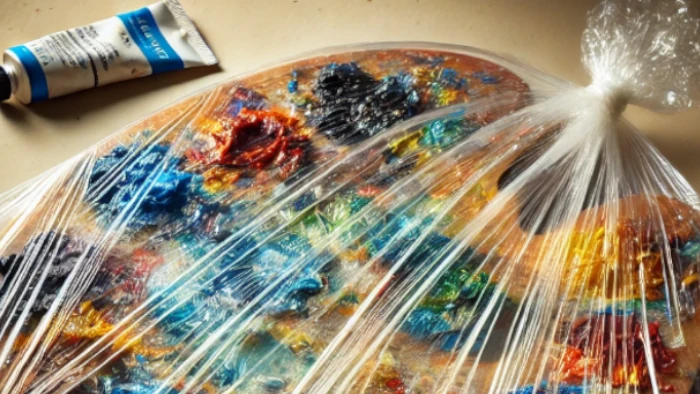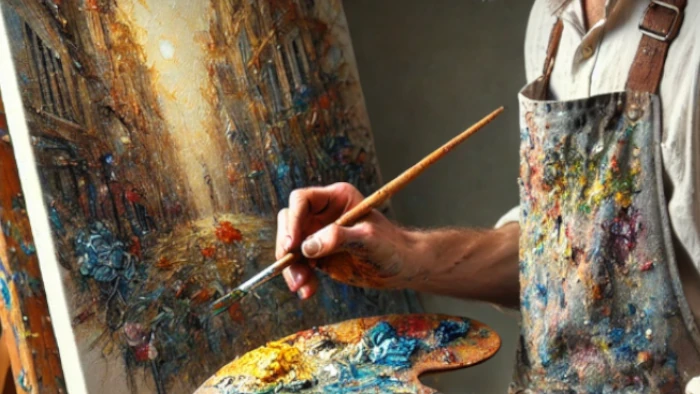
Basic palette
I spent a long time choosing high-quality oil paints at an affordable price. Through trial and error, I created my personal rating of professional art supplies. Here are the main brands whose paints I currently love:
- Master Class
- Sennelier
- Shminke Mussini
I’m mostly using Master Class and Pebeo now, although the latter didn’t suit me in terms of pigmentation and consistency—they’re too oily, like melted butter… I prefer something denser. I also have Ladoga (a more affordable brand from St. Petersburg) and Maimeri (Italy) in my collection. Among professional paints, Master Class is the most affordable in Russia, and the quality is excellent. The shades are vibrant, and the paint in the tube is thick and uniform, without leaking. Occasionally, you might come across tubes with leaks when buying paints, but I just avoid those. I prefer buying medium and large-sized tubes so I don’t have to worry about running out of the needed color at the wrong moment.
*The video is in English because I run an international art video channel, but I think you’ll understand everything.
Master Class has some particularly expensive pigments, with a tube costing up to 600 rubles, but most popular colors range from 200 to 300 rubles. You actually don’t need many colors for painting—you can get by with just the basics, though mixing paints will take a bit more time. It’s better to buy lighter and brighter shades separately, as it can be tricky to mix a bright orange, for example. I usually take three to four blues, several yellows, at least two reds, a brown, and plenty of white—both zinc and titanium. That’s my basic set.
Recently, I’ve started buying rare pigments—silver, gold, fuchsia, and the like. But I rarely use them in my work. What I enjoy most is taking a few colors and mixing my own palette from them. I feel it makes the painting more harmonious and stylish.
Lifehacks with oil
When it comes to oil paints, there are several tips that can make life easier for an artist and make the painting process more enjoyable. Take, for example, the famous artist Bob Ross. He always said that happiness is having enough paint to mix. You can’t argue with that. But even if you don’t want to stock up on giant amounts of paint like Bob, you can simplify things and keep your favorite shades on the palette longer by using a food wrap hack. Cover the palette, and the oil paints will stay fresh much longer—especially if you store it in the fridge!

Professionals recommend not skimping on brushes. The higher the quality of the brushes, the easier it is to apply precise strokes, achieve desired effects, and control the texture. It’s best to use not only bristle brushes but also soft sable brushes for smooth blending. I’ve tried many brushes myself and found that it’s ideal to have at least three main ones: a bristle brush for thick strokes, a synthetic one for detailed work, and a soft sable brush for blending layers.
By the way, another trick—if you want your strokes to remain textured and voluminous—try adding a little resin to the paint. Peter Paul Rubens used this technique to make his paintings look more lively and dimensional. Professional artists often use this method to create special textures on the canvas, adding depth and layers to the painting. You can experiment with binders and thinners to achieve different effects when applying paint to the canvas.

As for mixing colors, Van Gogh’s words come to mind: ‘Simple colors always work better.’ There’s no need to complicate your palette. Make it a rule to stick to basic colors and create nuances through mixing. The fewer colors on the palette, the more cohesive the painting will be, as the masters of the past have proven time and again.
The drawing process
A tip for those who love cleanliness and order while working—store your paints on a stand, organizing them by tone and saturation. This will help you quickly find the right color without disrupting your creative flow by digging through a pile of tubes. Plus, this way, your paints won’t ‘wander’ around the table, and you won’t end up elbow-deep in blue while reaching for a tube of red.
And of course, I can’t help but mention a seemingly small but important detail—cleaning your brushes. Clean brushes mean a clear conscience! Don’t neglect cleaning them, and your tools will last for years, while your works will shine with clear and bright colors.

Lastly—remember that in oil painting, the key is not to rush. Oil dries slowly, and that’s wonderful! Allow yourself to pause, wait, and reflect on each stroke. As Leonardo da Vinci said, ‘Art is never finished, only abandoned.’ Enjoy every moment of the process, and don’t forget that the most important thing is to take pleasure in creating your masterpieces!